My taste in plants is not exactly traditional. Somewhere along the line, when my gardening priorities shifted toward sustainability, my passion for pretty things morphed into an appreciation for survivalists. I’m fascinated by the ways in which plants have evolved to withstand voracious herbivores and fluctuating climate extremes. The tougher a plant is, the more I like it.
Where I garden in southwestern Oregon, we have a pseudo-Mediterranean climate that is becoming more of a wild card, as well as hordes of desensitized deer and exploding populations of various tunneling critters. Every year these conditions seem to intensify in different and unpredictable ways. So when I call a lethal-looking or odorous plant nasty, it is the ultimate compliment. This plant has harnessed the awesome powers of nature to thrive defiantly against all odds. Gardeners can employ the nasty properties of such plants as effective defenses in our ongoing battle to create beautiful, beneficial, and enduring gardens.
Thorny plants will keep the herbivores moving along
Grazing animals prefer their meals without a side of spikes or spines, so a hearty helping of prickly plants will help to dissuade those hungry beasts from treating your borders like a buffet. Plant the following nasties with care, in a spot where you can enjoy their fierce beauty from a distance.
‘Li’ jujube protects its sweet fruit with sharp thorns
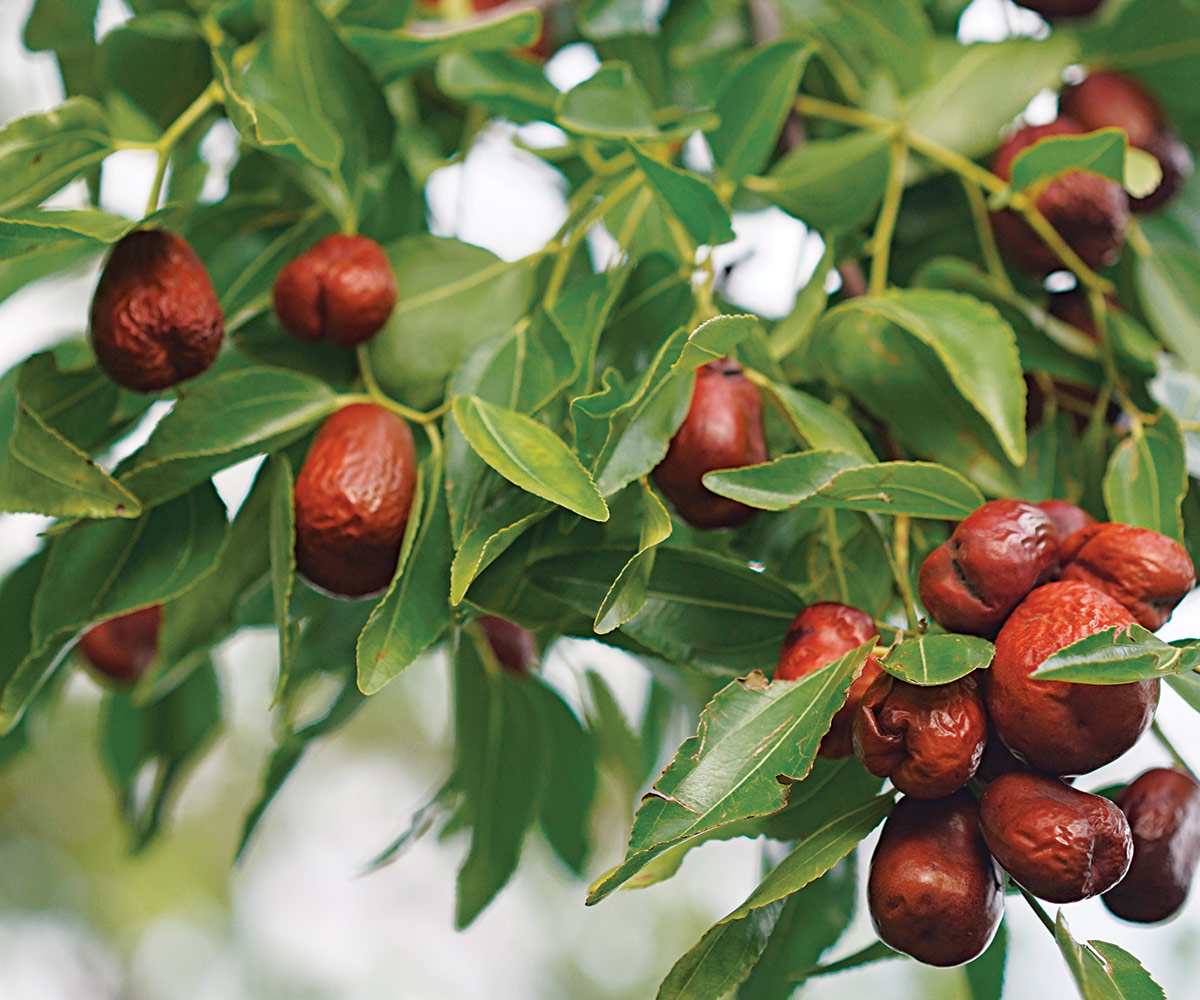
Name: Ziziphus jujuba ‘Li’
Zones: 6–9
Size: 15 to 20 feet tall and 15 feet wide
Conditions: Full sun to partial shade; average to dry soil
Native range: China
Jujubes are uncommon fruit trees that are usually sought out only by food foresters and folks who are culturally in the know. However, they deserve much wider recognition for their outstanding toughness and ornamentality. They have glossy, dark green foliage and a slightly weeping habit, especially when laden with a fall crop. The branches grow in a quirky zigzag pattern with vicious little thorns at each corner, particularly on new growth. Deftly avoiding late frosts, the tiny, pale green flowers fill the air with their light fragrance from early to midsummer. This durable tree actually prefers long, hot summers, which aid in ripening its copious fruits, and it can be quite drought tolerant once established. Regular pruning is not required, and it is untroubled by pests or diseases, though birds may take a share of the fruit. ‘Li’ is a variety prized for being more reliably self-fertile and for its large fruits, which taste like dry, crisp apples when fresh and more akin to dates when dried.
Winged thorn rose glows in the sun
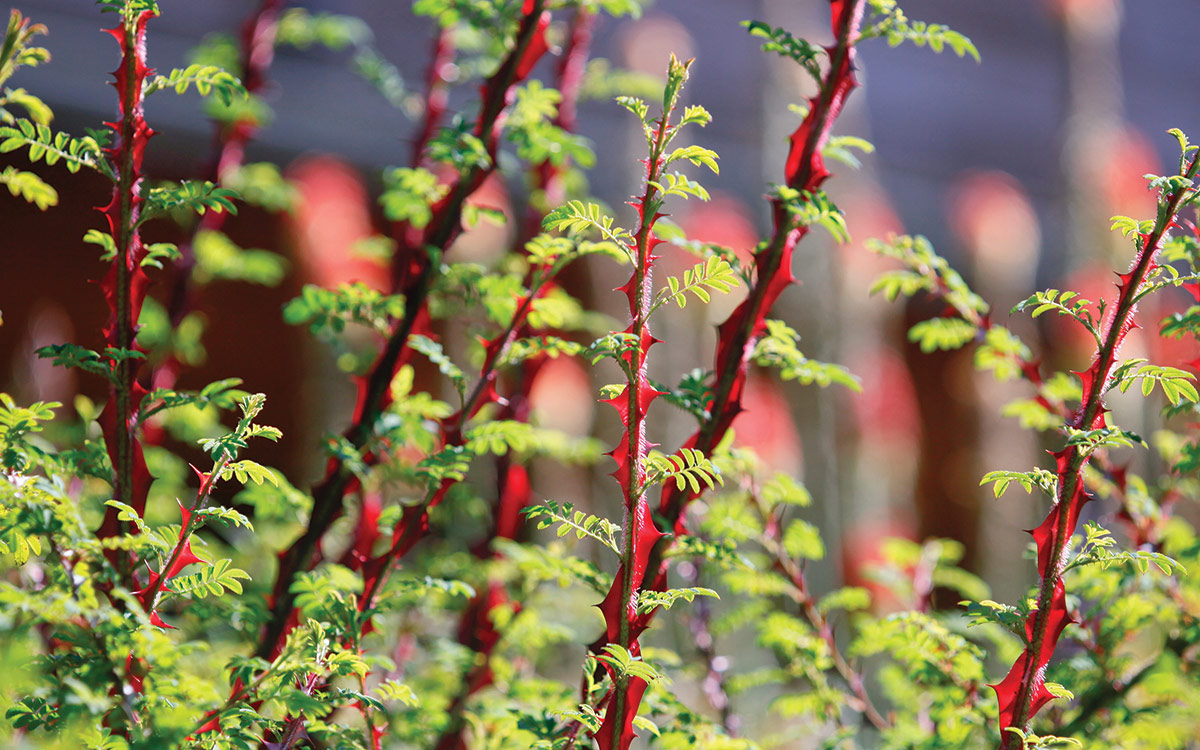
Name: Rosa sericea subsp. omeiensis f. pteracantha
Zones: 6–9
Size: 7 to 9 feet tall and wide
Conditions: Full sun to partial shade; adaptable to most soil types with good drainage
Native range: China, the Himalayas
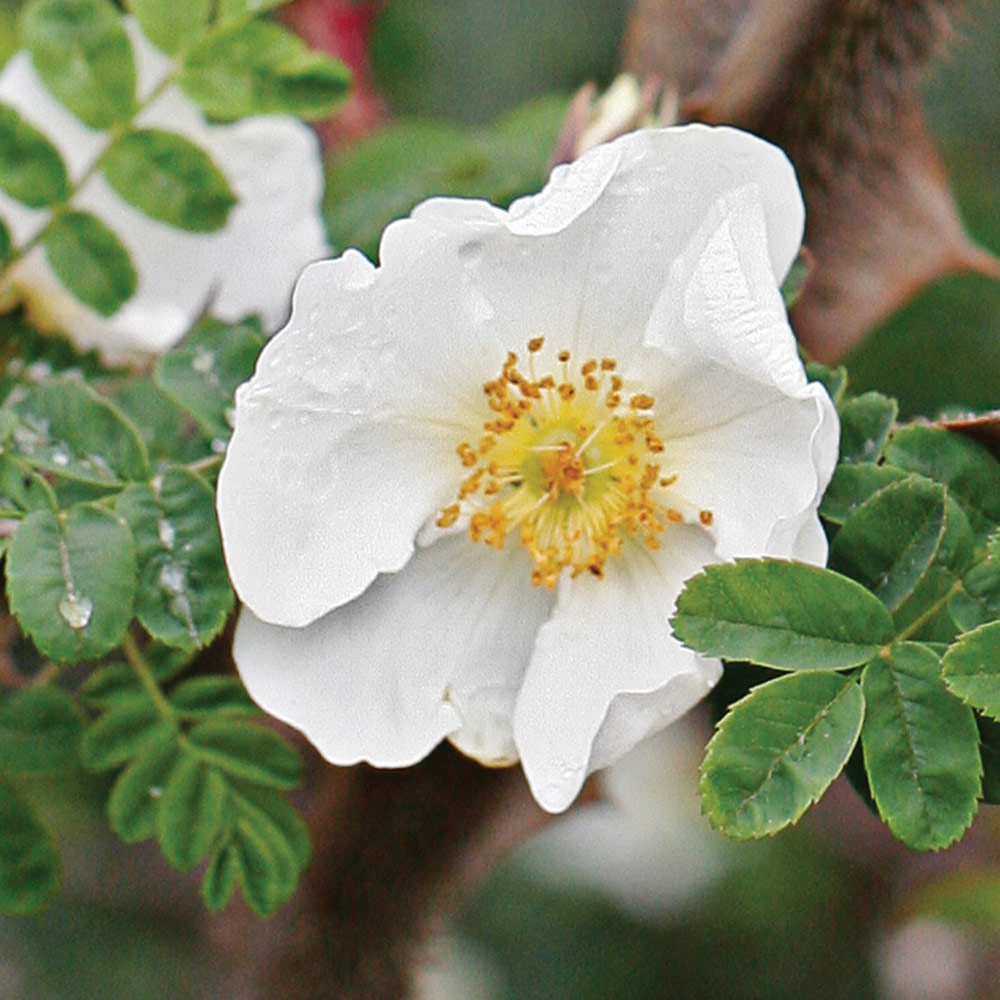
Winged thorn rose is distinctive among species roses, which are a massive and resilient group with significant wildlife value. I discovered it early in my nursery tenure and was immediately captivated; a rose whose thorns are its most prominent feature is nastiness encapsulated. New stems are trimmed out in translucent red thorns that are uniquely beautiful when backlit by morning or evening sun. Petite, blue-tinged pinnate foliage softens the display, along with a springtime explosion of white, sweetly fragrant, single blooms. As long as it gets enough sun, winged thorn rose will put up with a variety of challenges, including heavy clay and a spare watering regime. Prune out a third of the oldest canes annually in late winter to keep it freshly supplied with colorful first-year growth. This keeps its natural vase shape intact and leaves enough old wood for an abundant floral show followed by red rose hips.
Plains prickly pear is untouchable but intriguing
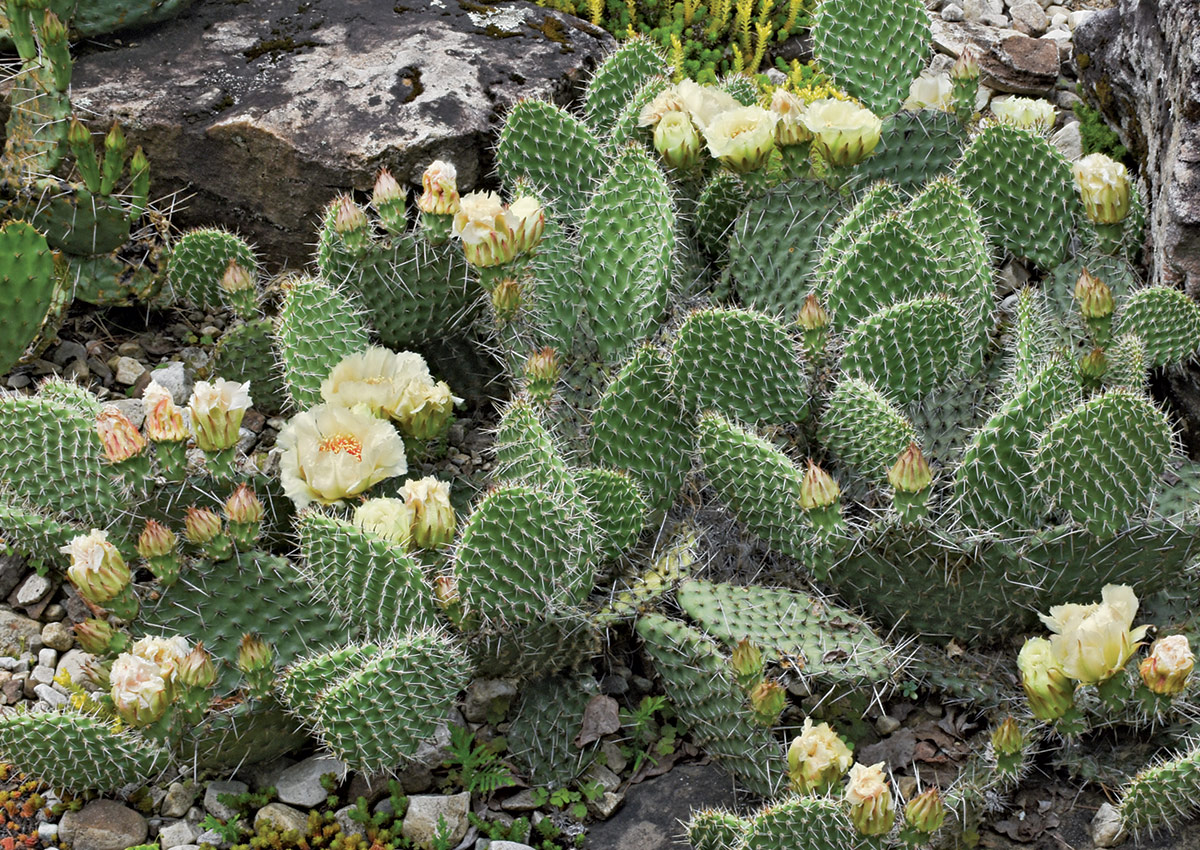
Name: Opuntia polyacantha
Zones: 3–8
Size: 6 to 18 inches tall and 24 to 36 inches wide
Conditions: Full sun; lean, sharply drained soil
Native range: Middle to high-elevation areas of western and central North America
A deep dive into the hardy cactus world reveals more than 90 Opuntia species native to the United States, so no matter where you live there is a prickly pear suited for your conditions. Plains prickly pear is the most widely distributed species, with countless named selections, subspecies, and hybrids that showcase an amazing array of forms and flower colors. In early summer, the showy, cup-shaped blooms support numerous pollinators, including many butterflies and moths. Bulbous, berry-toned fruits add a second wave of interest, and though these are commonly dry at maturity, they are still foraged by wildlife. Naturally dwarf in habit, this prickly pear spreads to form tightly packed colonies that are perfect for hellstrips and rock gardens. Obviously, the barbed spines are a natural defense mechanism, but along with the smaller clustered spines, called glochids, they also act as sun reflectors to protect the leaf pads.
Gnarly textures are appealing to the eye but unappetizing to animals
Tough leaves are a turnoff for foragers, but these resilient foliar textures are often very attractive additions to a garden design. Planting an architectural yucca, a glossy tea olive, or a prickly poppy is the perfect way to spike a garden bed with textural appeal.
‘Sasaba’ holly tea olive is stunning when lightly pruned
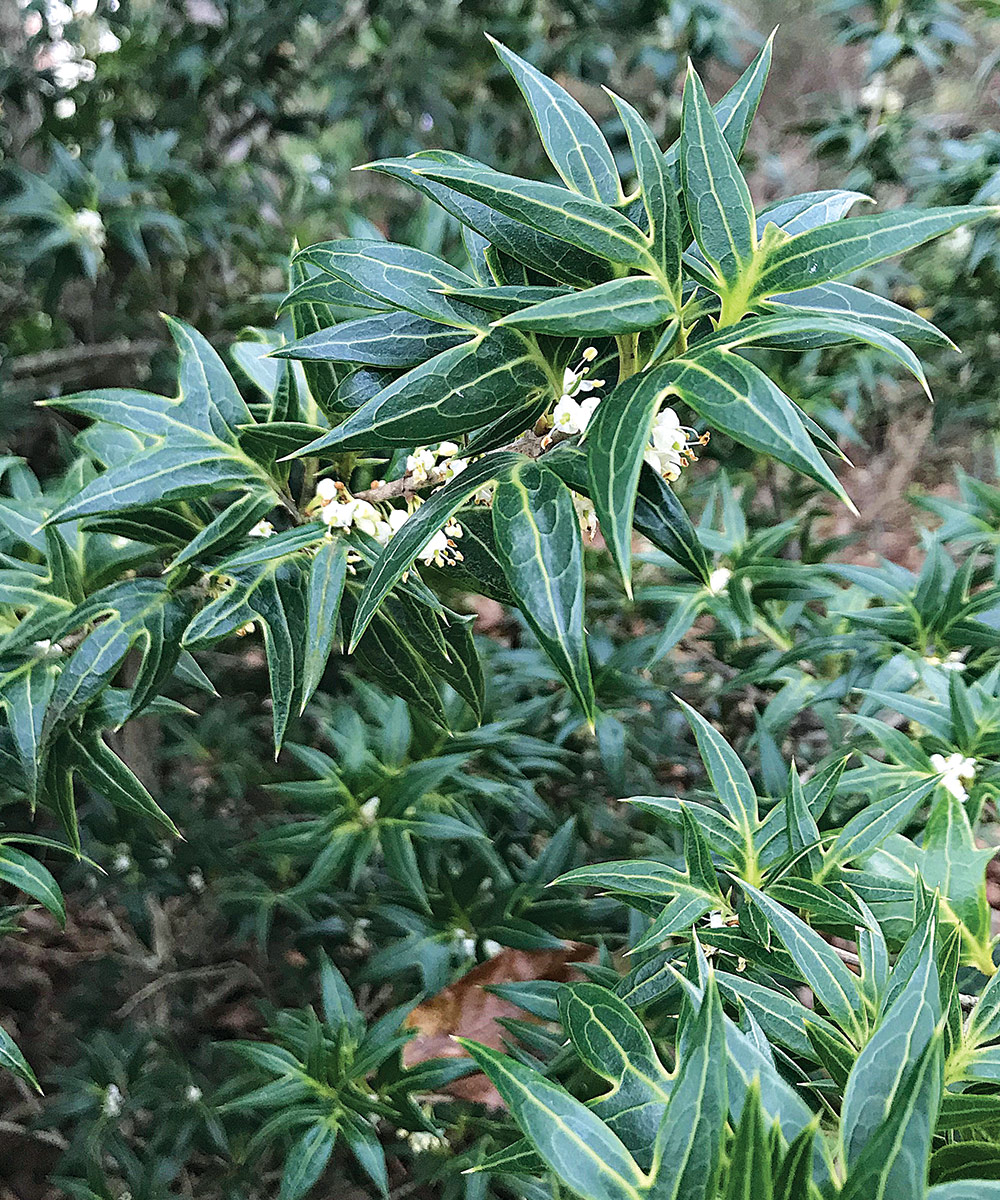
Name: Osmanthus heterophyllus ‘Sasaba’
Zones: 6b–10
Size: 4 to 9 feet tall and 4 to 6 feet wide
Conditions: Full sun to partial shade; average, well-drained soil
Native range: Japan, Taiwan
When I first saw ‘Sasaba’ holly tea olive, the wildly different texture of its lethally pointed leaves put stars in my eyes. It has a sculptural quality that is rare in broadleaf evergreens—rigidly bold and eccentric without the wispy ranginess associated with many shrubs. If you are willing to brave the barbaric foliage, a little selective shaping will transform ‘Sasaba’ from a great barrier shrub into a worthy centerpiece, even in a garden plagued by browsing animals. In fall or early winter, tiny white flowers cluster around the leaf axils, sweetly perfuming the air and drawing attention before they are visibly noticeable. The dark, glossy leaves are set off beautifully by bright gold, chartreuse, or variegated neighbors. ‘Sasaba’ has a rugged makeup that allows it to handle heat and poor soil conditions, even clay, with ease. It can also take quite a bit of shade. Only occasional pruning is needed to maintain a stellar shape.
‘Sapphire Skies’ beaked blue yucca looks sharp and sophisticated
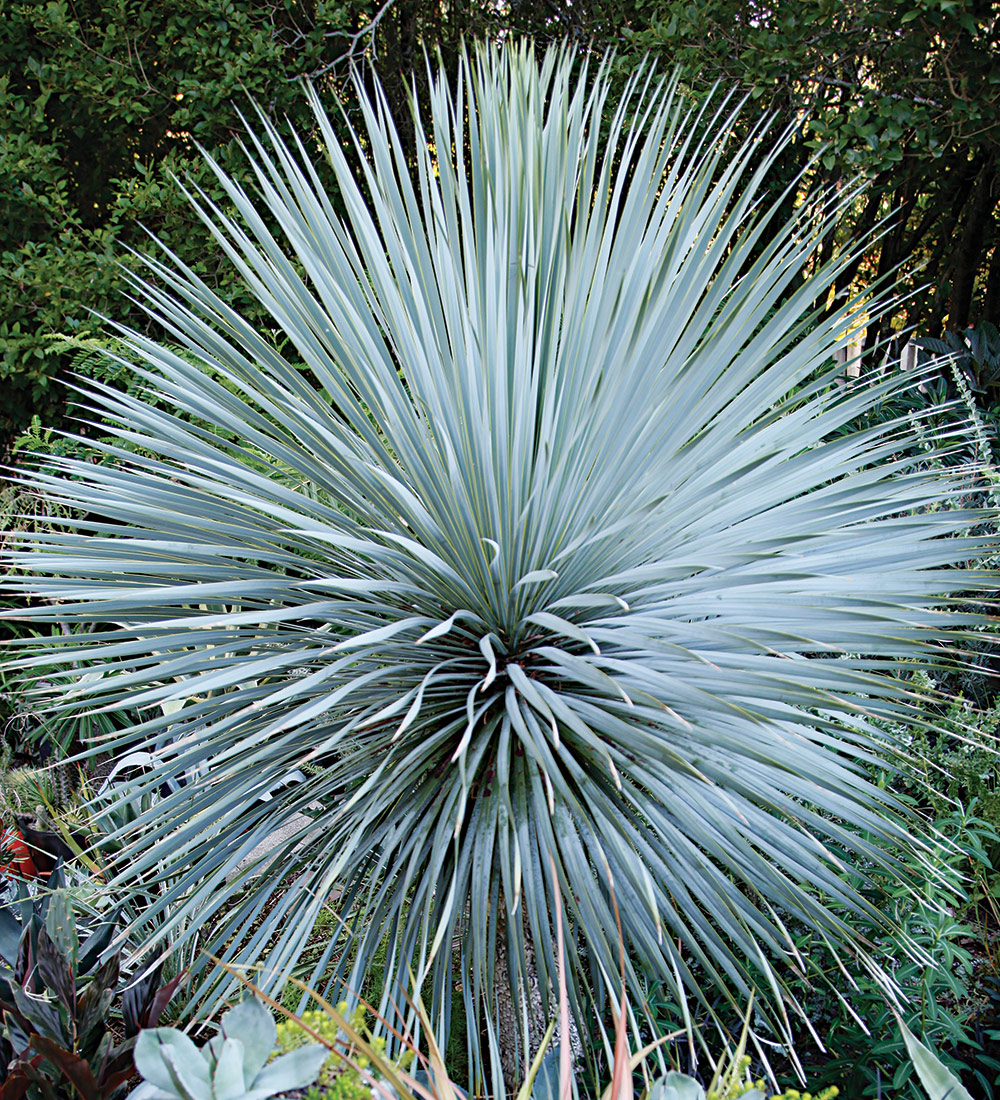
Name: Yucca rostrata ‘Sapphire Skies’
Zones: 5–11
Size: 5 to 10 feet tall and 3 to 8 feet wide
Conditions: Full sun; lean, sharply drained soil
Native range: Northern Mexico
‘Sapphire Skies’ elevates its genus to new heights, with architectural perfection that makes it a wonderfully audacious focal point for a dry, sunny location. This especially hardy cultivar was collected and selected by well-known plantsman Sean Hogan. As the plant ages, it slowly forms a trunk that you can highlight by removing lower leaves, revealing the intricate geometric patterns created by the cut ends. A starburst of flexible, platinum blue blades sits atop the trunk. Do not be deceived by the foliage’s flimsy appearance; it still packs a sharp punch at the tips if it is approached too casually. Full sun and excellent drainage are the keys for success and steady growth; planting in rich soil or too much shade will soften and green up its steely demeanor. As it gains maturity, fat Seussian spikes of ivory bells erupt from its apex, a celebratory summer event for appreciative pollinators, hummingbirds, and humans.
Horned poppy pairs frosty foliage with sunny blooms
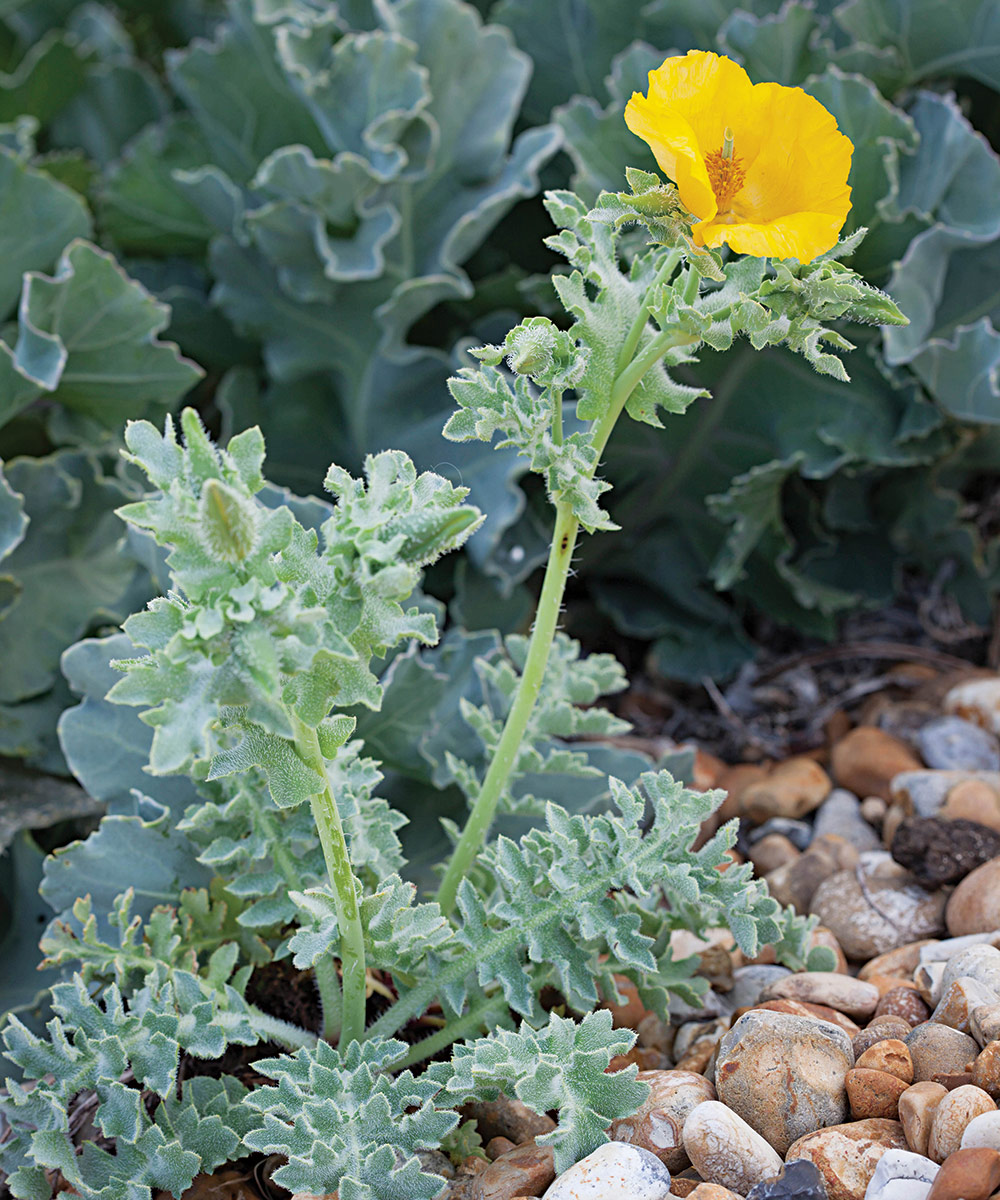
Name: Glaucium flavum
Zones: 6–9
Size: 18 to 24 inches tall and wide
Conditions: Full sun; lean, sharply drained soil
Native range: Coastal Europe, North Africa, western Asia
With plenty of savage attributes plus an affinity for hellish hot spots and lean, gravelly soil, horned poppy is one tough dude. It looks amazing in winter, especially when the deeply incised, wavy-edged leaf stalks are crisply outlined in frost and its silvery blue color feels like something out of an arctic fantasy. Its bristly texture deters browsing critters, and since all parts are poisonous, especially the roots, underground tunnelers will also leave it alone. In early to midsummer, honey-gold blooms glow against the glaucus foliage, followed by 6- to 12-inch, upward-curving seedpods. Like many poppies, this one can be short-lived and tricky to transplant due to its taproot. However, you can easily collect seed from the hornlike pods to sprinkle about, or simply leave the pods intact and celebrate the subsequent bounty of seedlings.
Stinky plants can serve as bodyguards for tastier neighbors
If herbivores smell something nasty from a distance, they may choose to avoid the area to seek out a sweeter-smelling meal elsewhere. Planting something unpleasantly aromatic can therefore deter animals from browsing in its general vicinity, allowing you to sneak in a few plants that might otherwise tempt them. Here are some odiferous favorites.
‘Sea Foam’ artemisia is the perfect foil for bright blooms
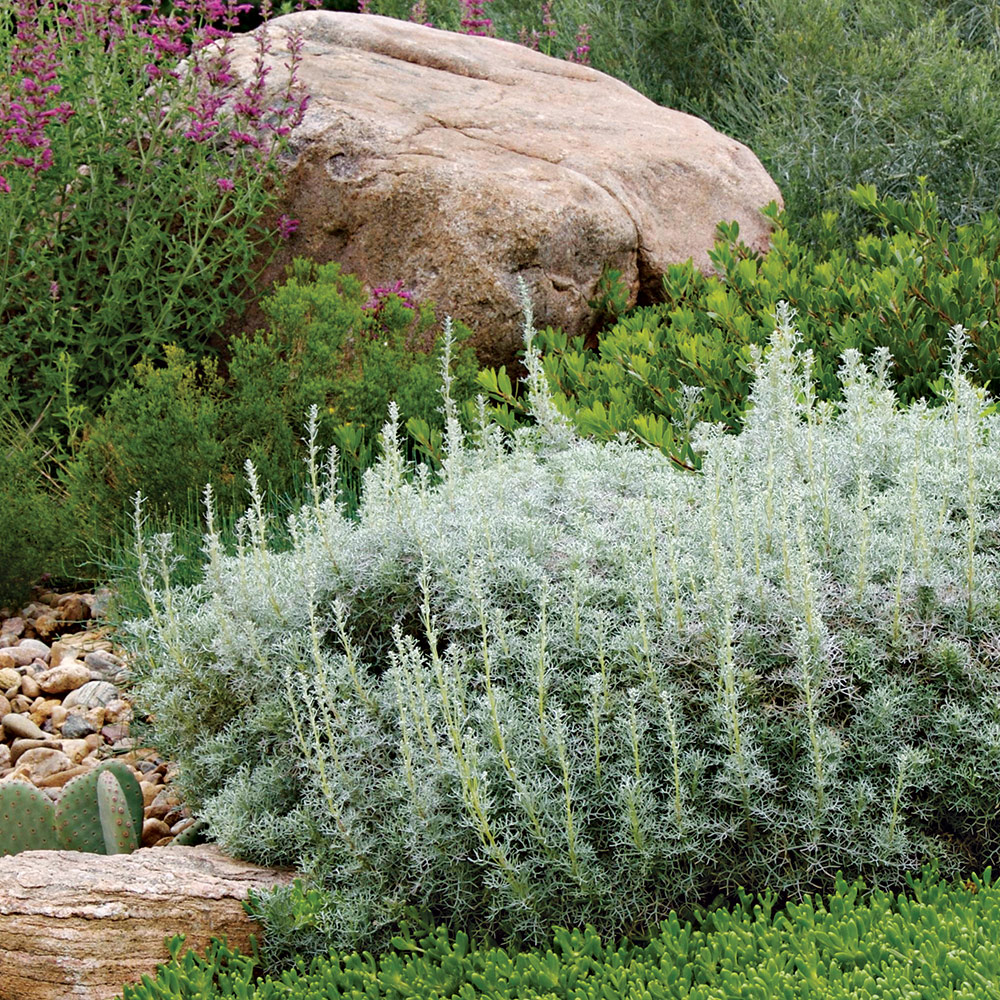
Name: Artemisia versicolor ‘Sea Foam’
Zones: 4–9
Size: 12 to 18 inches tall and 24 to 30 inches wide
Conditions: Full sun; lean, well-drained soil
Native range: Garden origin
Topping the short list of artemisias worth collecting, this introduction from esteemed garden designer Lauren Springer is a fabulous juxtaposition of delicate appearance and staunch constitution. All aspects of the contorted, finely textured foliage are biologically adapted to endure punishingly hot and dry environments, and it has the classic aroma of sun-warmed chaparral sage brush that deters critters both large and small. Mid to late summer brings creamy wands of tiny dangling blooms extending from the branch tips, adding a wispy yet dry dimension to the overall texture. If these inconspicuous nubbins are not your cup of tea, they can be pruned away for a cleaner look. ‘Sea Foam’ has been deciduous in my garden, which I actually find advantageous. Giving the woody stems a hard chop in early spring is an easy way to avoid the unsightly ranginess that can factor against the larger evergreen members of this genus. Spreading slowly to form a broad, low mass, ‘Sea Foam’ mingles politely with neighbors, setting off contrasting foliage and bright blooms beautifully. It is perfect at the front of a baking border, in a hellstrip, or as a coral substitute in that under-the-sea-themed rock garden you’ve always wanted to create.
Gray creeping germander has a sweetly funky scent
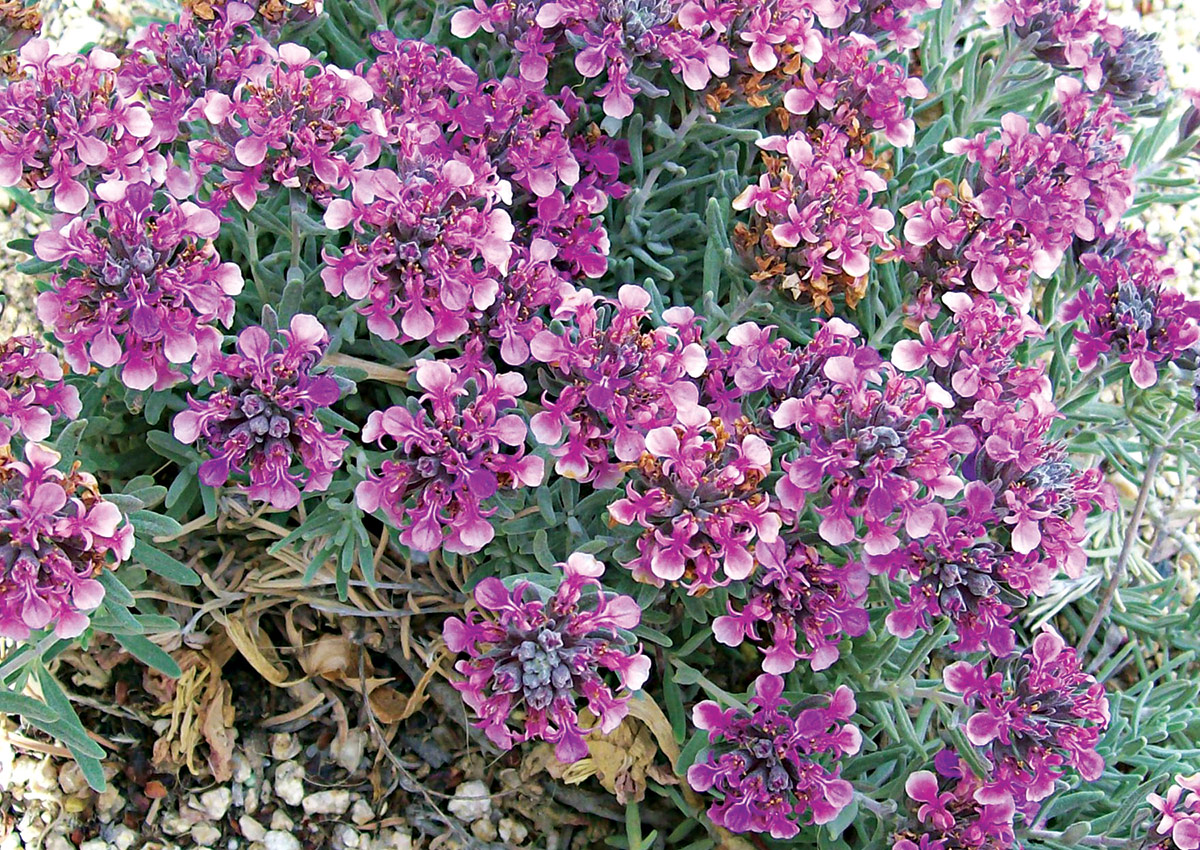
Name: Teucrium aroanium
Zones: 6–9
Size: 6 to 8 inches tall and 12 to 24 inches wide
Conditions: Full sun; lean, well-drained soil
Native range: Greece
Gray creeping germander is a stalwart that loves lean soil, ample sun, and heat. A perfect ever-silver edger, it is ideal for adding color to xeric borders, along paths, or draping over masonry walls. When brushed or crushed, the foliage emits a fruity herbal smell much more aromatic than that of its cousins. Starting in late spring its flat, mauve-tinted buds slowly open to smother the broad mat of needle-like leaves in light plum flowers. Their aroma has a fruity undertone, with pungent, overly ripe notes combined with hints of rich honey. The scent is right on the cusp between pleasant and foul, so how it is perceived is subjective, but bees and other pollinators are less persnickety and relish the feast. Once the floral party commences, lightly shearing the whole patch keeps things neat and tidy and is the only annual maintenance needed. If in time this germander starts to look mangy, you can give it a harder haircut in early spring.
‘October Skies’ aromatic aster doesn’t smell bad to humans, but deer think it stinks
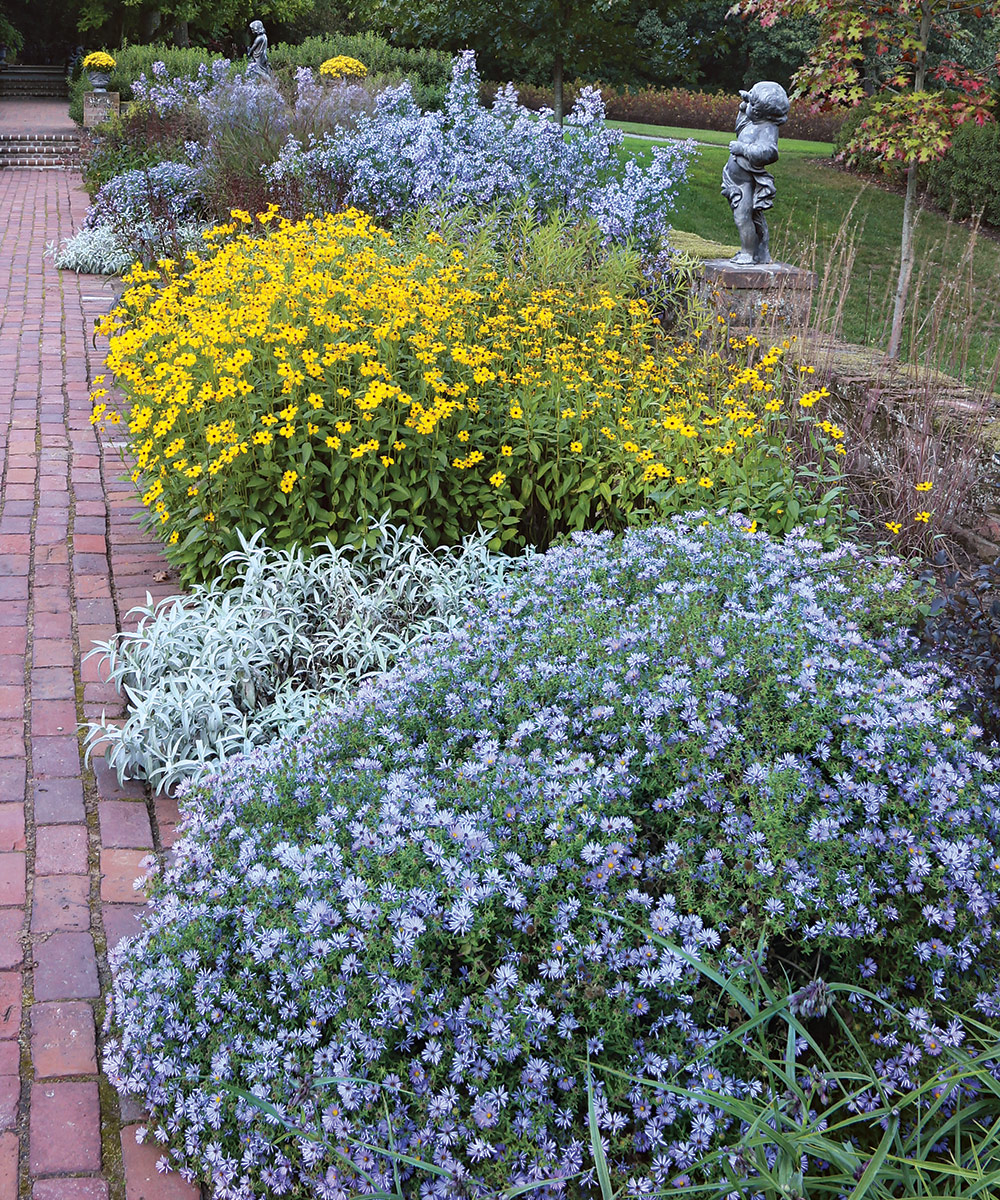
Name: Symphyotrichum oblongifolium ‘October Skies’
Zones: 5–8
Size: 18 to 24 inches tall and 24 to 30 inches wide
Conditions: Full sun to partial shade; lean to average soil
Native range: Central and eastern United States
I know what you’re thinking—how can an aster be nasty? A number of years ago I was on a mission to find a more drought-tolerant and deer-resistant aster for a pollinator garden. After much research, I came across this aromatic species that is native to rockier, drier soils, and it has not disappointed. The foliage is pungent enough to ward off even the most obnoxiously unpicky deer, and it seems to hold up well in triple-digit temperatures. It is invaluable for those tricky partial-sun spots that are still intensely hot, and it is also great on gentle slopes, where its rhizomatous roots help to prevent erosion and stabilize soil. It even abides clay and compacted soil. While many other asters finish blooming by the end of summer, in early fall ‘October Skies’ is just getting started. It’s hard to take the suspense, but once the silver-dollar-size, clear lavender daisies explode into a broad dome of color, you will know it was worth the wait.
Toxic plants are especially nasty, so proceed with caution
Plants that are poisonous must be treated with respect and should be planted away from edibles and other locations where children, pets, or livestock may be tempted to sample them. With the proper precautions in place, these sinister sirens will add another dimension of interest and pest resistance to your garden.
‘Arendsii’ azure monkshood brings lush color to the late-summer garden
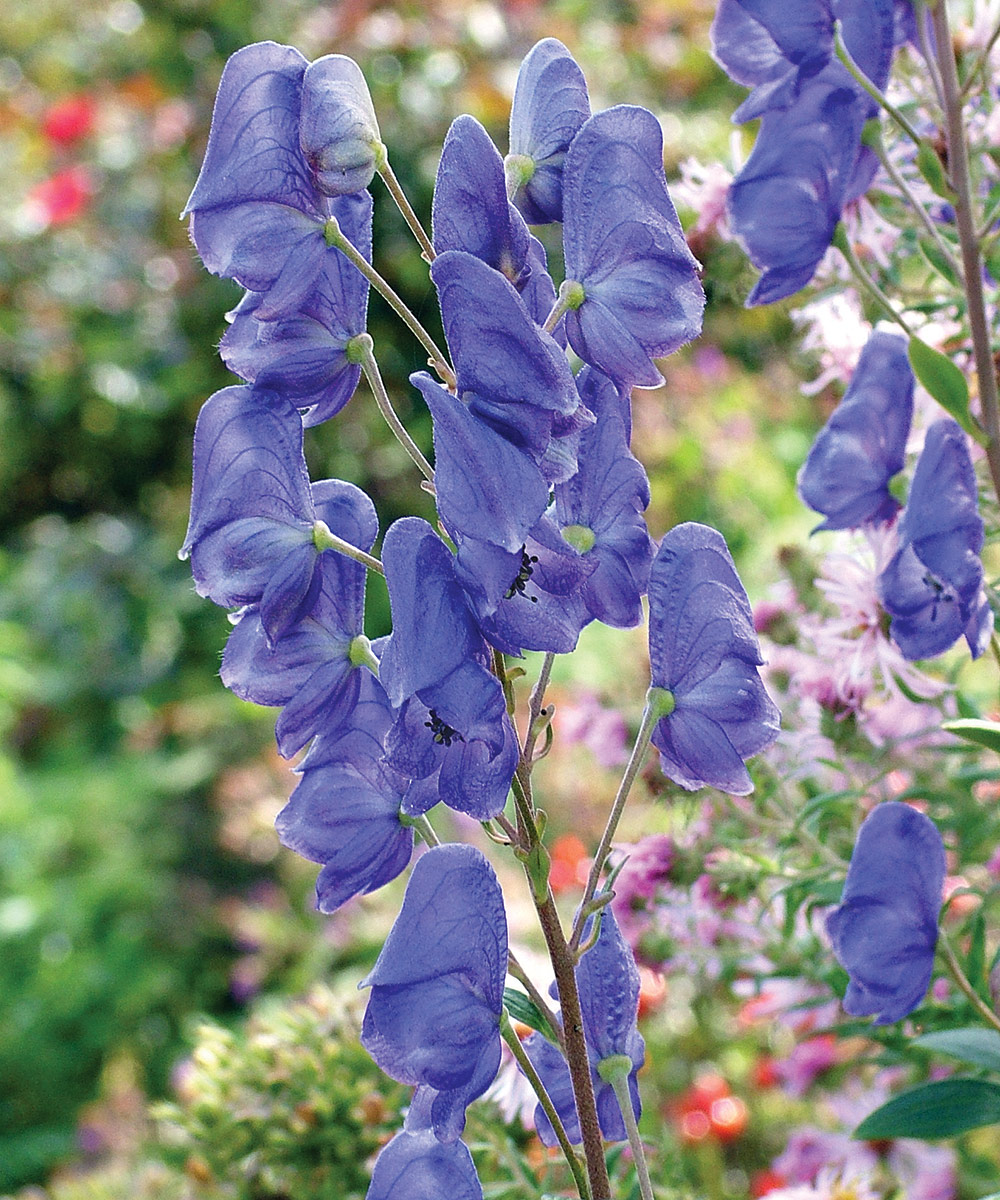
Name: Aconitum carmichaelii ‘Arendsii’
Zones: 3–9
Size: 24 to 48 inches tall and 18 to 24 inches wide
Conditions: Partial shade; rich, consistently moist, well-drained soil
Native range: China
Many plants are toxic to a degree, but monkshood is actually deadly if ingested. This lethal trait has kept it from being a perennial staple; nevertheless, the saturated color it brings to the garden after the spring crescendo deserves to be spotlighted. Dramatic panicles of hooded blooms festoon its extra stout stems in late summer, and deadheading can encourage a second wave of blooms in autumn. Tuberous roots and leathery foliage help the plant retain moisture, but it still prefers cooler temperatures and evenly moist soil. This can be tricky in excessively hot and dry climates, where afternoon shade is a must. A healthy mulch layer will also conserve moisture, but be careful to keep it clear of the crown to avoid rotting. Wear gloves and keep your skin covered when handling this plant, especially its roots and seeds.
Sunset foxglove lends a cottage vibe to a dry spot
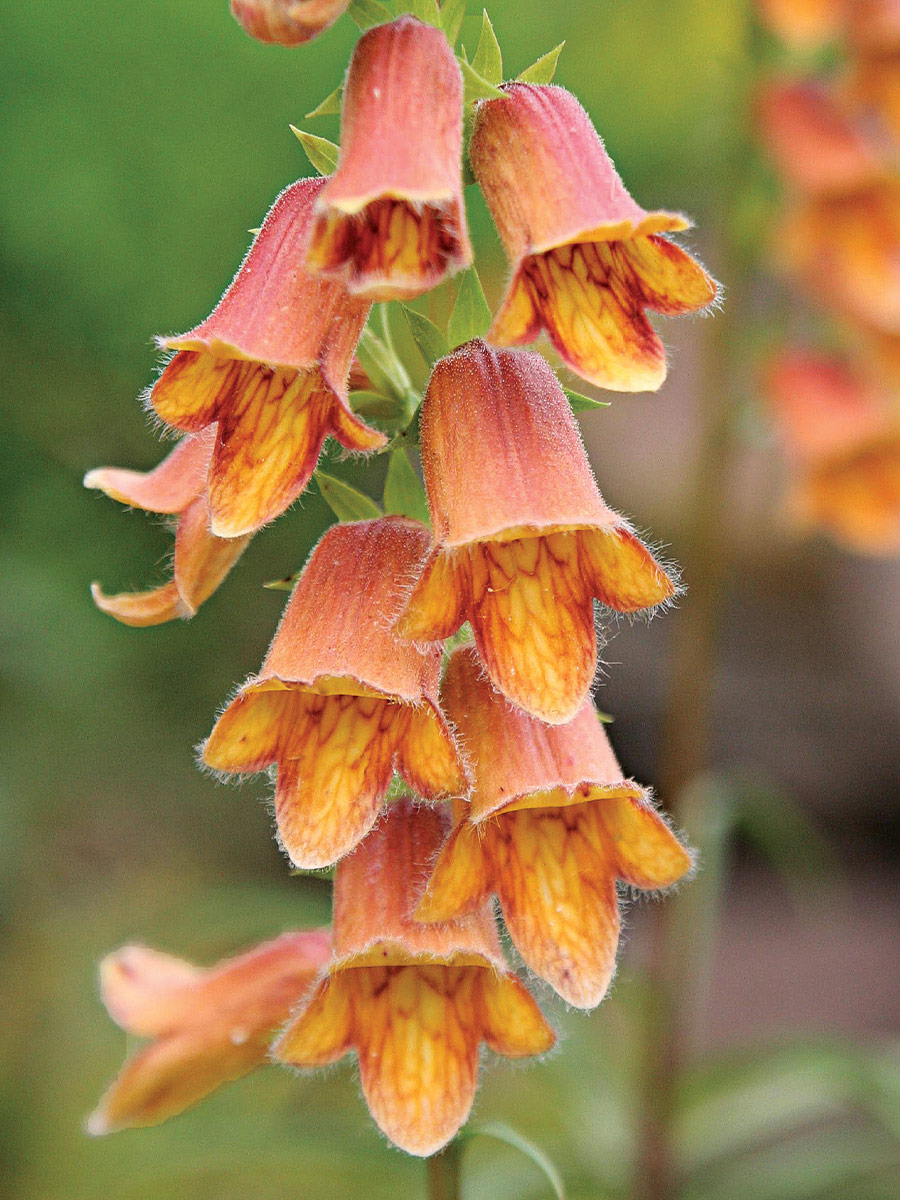
Name: Digitalis obscura
Zones: 5–9
Size: 18 to 24 inches tall and wide
Conditions: Full sun; dry to average, lean, well-drained soil
Native range: Spain, Portugal
This reliably perennial Iberian treasure does not require the ample shade and moisture preferred by traditional English cultivars. Completely at odds with its precocious woodland cousins, sunset foxglove thrives in sun-drenched, poor soil reminiscent of its Mediterranean homeland. Its straplike, leathery foliage remains evergreen in mild winters, though it can still benefit from a cutback in early spring. Summer brings racemes of rusty amber-orange blooms with molten interiors, hues that appeal to moody palettes. Site it among silvery counterpoints, or near plants with cream, plum, periwinkle, or chartreuse flowers. I only wish I’d discovered this unique foxglove sooner.
Narrow leaf milkweed shrugs off heat, drought, and bad soil
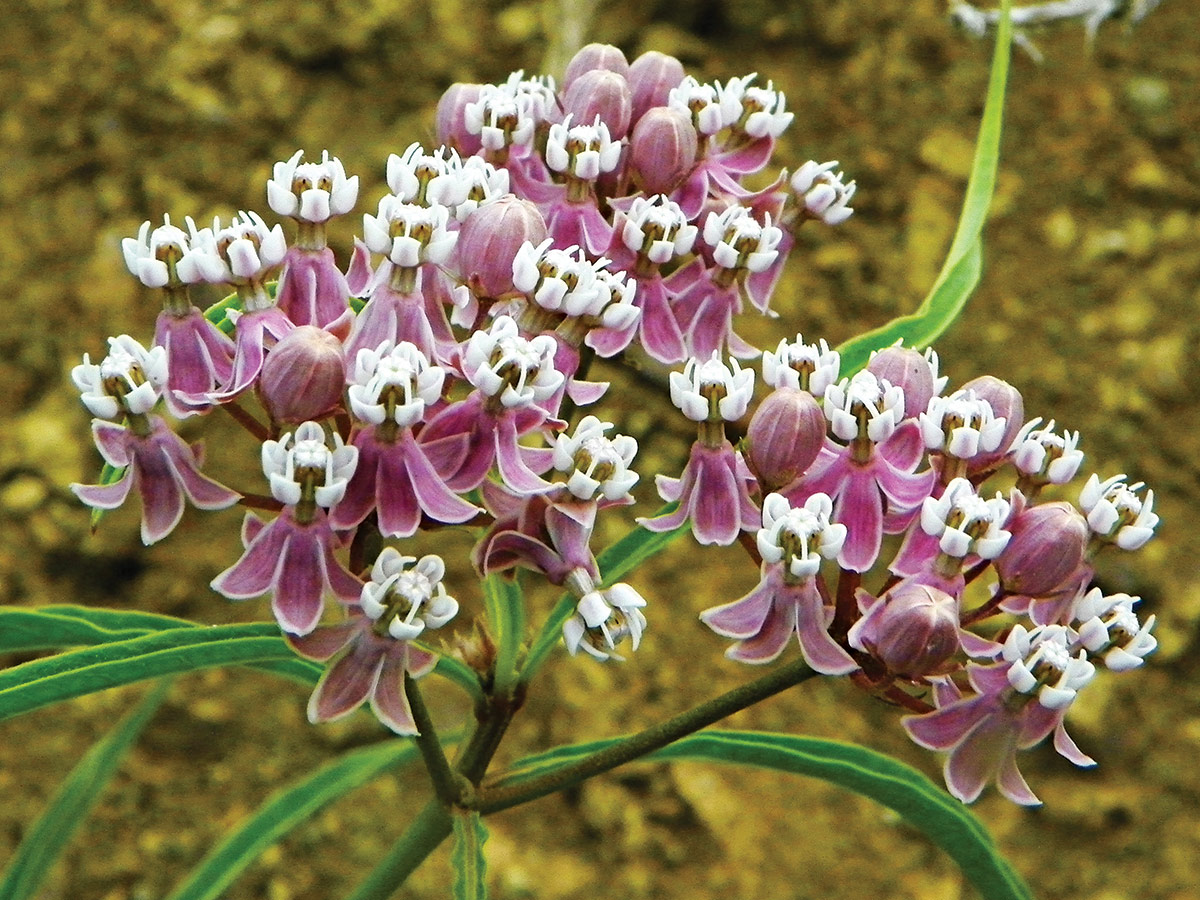
Name: Asclepias fascicularis
Zones: 6–10
Size: 2 to 3 feet tall and wide
Conditions: Full sun to partial shade; adaptable to a wide range of soil conditions and moisture levels
Native range: Western United States
This irrepressible denizen of abandoned lots and sidewalk cracks is also surprisingly garden tolerant, even in clay. Unlike many wildflowers that rely on summer dormancy, it can manage without irrigation through intense heat and drought. Siting it in a hot, dry spot will keep it from colonizing rampantly by underground roots, as it can do in cushier conditions. It is a valuable host plant for monarch caterpillars, who protect themselves from predators by consuming its leaves and stems, which are laced with toxic alkaloids. The willowy foliage, which lends a grassy quality to plantings, is topped in early summer by flowers that inspire frenzied pollinator activity, followed by oblong seedpods filled with silky fluff. This milkweed makes an excellent filler for the neglected, challenging areas of your property. It is easiest to propagate from root division rather than from seed.
Advice for siting your favorite nasties
Working with a cast of delightfully devilish characters calls for a bit of extra planning and creativity. The trick is to maximize their best attributes while minimizing inadvertent exposure to their nastier qualities. Here are a few ideas to consider.
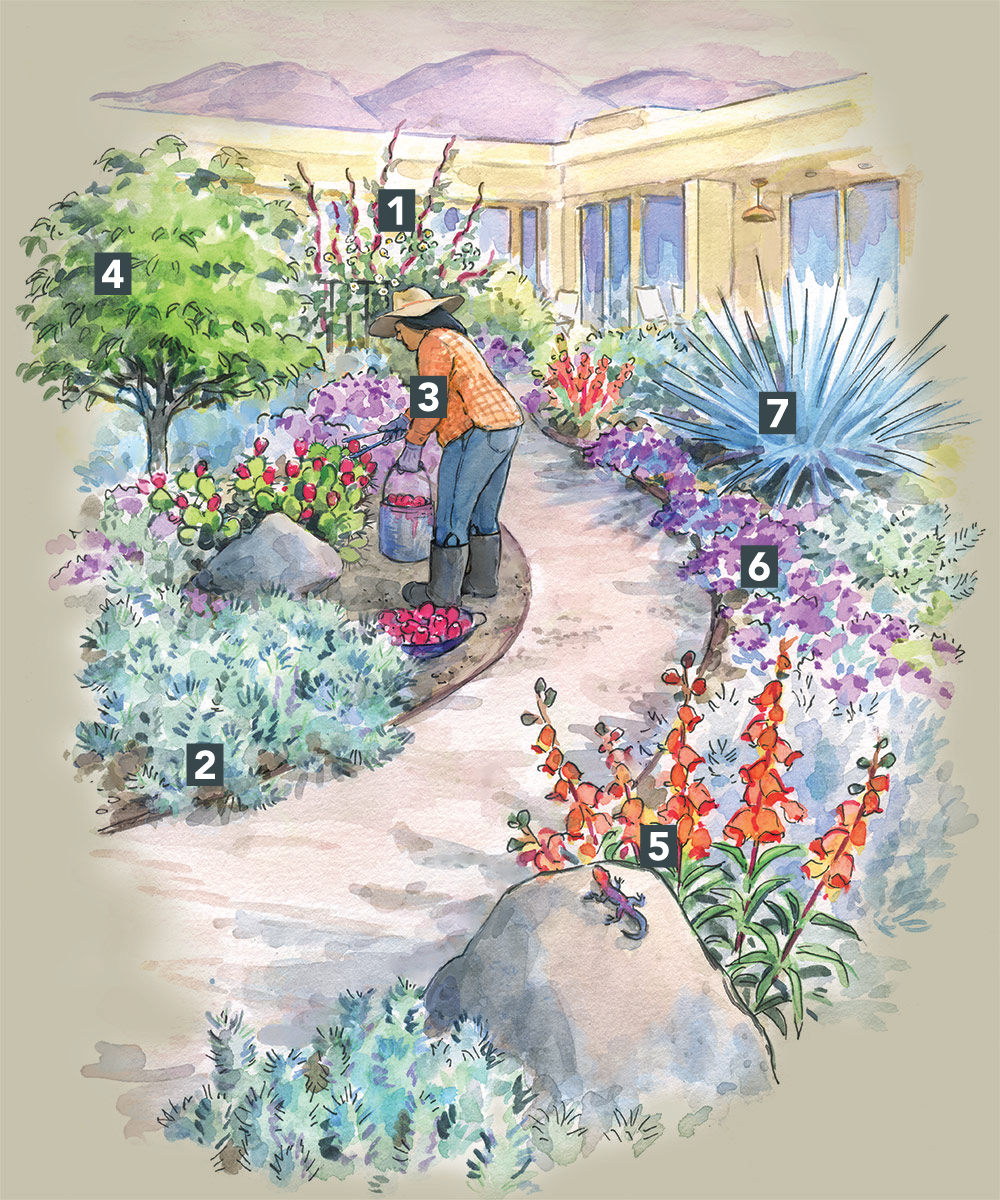
1. Backlighting heightens the drama
Place heavily textured plants where the rising or setting sun will create a spotlight and a glowing focal point.
2. Drainage is key
When growing desert dwellers and Mediterranean sorts, berming up your soil or adding gravel to the bottom of your planting hole can increase drainage at the root zone. Mulching with fine gravel helps keep moisture away from stems and foliage, particularly in winter.
3. Protect yourself
Wear thicker gloves and long sleeves when handling or pruning spiky or thorny plants. Old thrift-store kitchen tongs can be handy for picking up cacti, or you can just be sure to hold the pads carefully in the smooth areas between spines and glochids.
4. Pamper marginally hardy plants
Site plants that are not quite hardy to your area in protected microclimates close to a wall or foundation, under the shelter of a tree canopy, or on the leeward side of an evergreen wind barrier. Boulders can also be used as heat sinks to create sheltered nooks for small plants, and a well-placed sculpture or decorative panel might also do the trick.
5. Start heat lovers a little later
For plants that are sensitive to cold, wet weather, or freeze-thaw cycles, plant in late spring to early summer to get roots well established before winter. Stop watering early enough in fall to harden them off before the cold season.
6. Keep maintenance in mind
When choosing neighbors for your spiky plants, think about the ease of maintaining them in proximity to pokiness. The less pruning or weeding needed, the better.
7. Prevent plant attacks
Spiky or thorny plants should be sited away from paths, house foundations, and any other locations where they might injure someone.
Bonni Engelhardt is a landscape designer who lives and gardens in southern Oregon.
Sources
The following mail-order retailers offer many of the plants featured in this article:
- Annie’s Annuals and Perennials, Richmond, CA; 510-215-330; anniesannuals.com
- Dancing Oaks Nursery and Gardens, Monmouth, OR; 503-838-6058; dancingoaks.com
- Digging Dog Nursery, Albion, CA; 707-937-1130; diggingdog.com
- High Country Gardens, Williston, VT; 800-925-9387; highcountrygardens.com
- Phoenix Perennials and Specialty Plants, Richmond, BC; 604-270-4133; phoenixperennials.com
